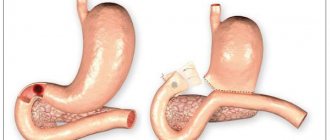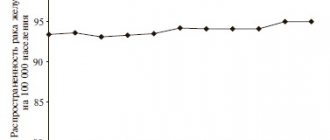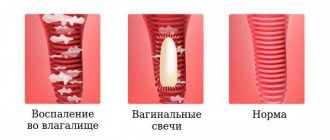The first option for first-line treatment of peptic ulcer disease
One of the proton pump inhibitors (omeprazole, lansoprazole, pantoprazole, rabeprazole, esomeprazole) in a standard dosage and clarithromycin 500 mg in combination with amoxicillin 1000 mg or metronidazole 500 mg (respectively, all drugs are prescribed 2 times a day) for at least 7 days.
Note: assessment of the effectiveness of treatment of patients in the healing of ulcers of the duodenum and stomach is carried out, according to the results of the control endoscopy, on days 8-9 from the start of treatment of patients; in the absence of ulcer healing, continue treatment of patients with one of the proton pump inhibitors in a standard dosage 2 times a day for another 3 weeks.
Clinical picture of peptic ulcer
The most consistent and important symptom of peptic ulcer disease is pain. Pain in peptic ulcer disease has a clearly defined rhythm (time of occurrence and connection with food intake), and seasonality of exacerbations.
Based on the time of occurrence and their connection with food intake, pain is distinguished between early and late, night and “hungry”. Early pain occurs 0.5–1 hour after eating, lasts 1.5–2 hours and decreases as gastric contents are evacuated. Such pain is more typical for gastric ulcer in the upper part.
Late pain appears 1.5–2 hours after eating, night pain occurs at night, and “hungry pain” occurs several hours after eating and stops after eating. Late, night and “hungry” pains are more typical for the localization of an ulcer in the antrum of the stomach or duodenal ulcer.
The nature and intensity of pain may vary (dull, aching, burning, cutting, cramping). The localization of pain in peptic ulcer disease is different and depends on the location of the ulcer: with an ulcer on the lesser curvature of the stomach, pain often occurs in the epigastric region, with duodenal ulcers - in the epigastric region to the right of the midline. With ulcers of the cardial part of the stomach, pain can be behind the sternum or in the heart area; in this case, it is important to differentiate peptic ulcer disease from angina pectoris or myocardial infarction. Pain often occurs after taking antacids, milk, food, and even after vomiting.
In addition to pain, the typical clinical picture of peptic ulcer disease includes various dyspeptic symptoms.
Heartburn is one of the early and frequent symptoms characteristic of peptic ulcer disease. Heartburn can occur at the same time after eating as pain. It often precedes the onset of pain, and subsequently is often combined with pain. These two symptoms are closely related, and some patients have difficulty distinguishing between them. In later stages of the disease, heartburn may disappear. But sometimes it can be the only subjective manifestation of a peptic ulcer.
Belching is a fairly common, but not specific symptom of peptic ulcer disease. The most typical belching is sour. The appearance of belching is associated with impaired evacuation of gastric contents due to prolonged spasm and severe inflammatory edema of the pylorus or duodenal bulb. It should also be remembered that belching is characteristic of a diaphragmatic hernia.
Nausea and vomiting are dyspeptic symptoms characteristic of exacerbation of peptic ulcer disease. Nausea is often accompanied by vomiting, although vomiting can occur without preceding nausea.
Vomiting in patients with peptic ulcer disease often has some specific features: firstly, it occurs at the height of pain, being, as it were, the culmination of pain; secondly, it brings significant relief. Vomit, as a rule, has an acidic reaction with an admixture of recently eaten food. Vomiting can also occur on an empty stomach.
Appetite in case of peptic ulcer is usually preserved or even increased (the so-called painful feeling of hunger). Decreased appetite is possible with severe pain syndrome; fear of eating may occur due to the possibility of pain occurring or increasing. Decreased appetite and fear of food can lead to significant weight loss for the patient.
Constipation is observed in half of patients with peptic ulcer disease, especially during exacerbation. Constipation in peptic ulcer disease is caused by a number of reasons: spastic contraction of the colon, a gentle diet, poor coarse fiber and the resulting lack of intestinal stimulation, limitation of physical activity, and the use of antacids (Almagel, etc.).
Symptoms depend on the location of the ulcer and the age of the patient . In some cases there may be no pain (painless ulcers). In these cases, ulcers are discovered when complications develop (ulcer bleeding, ulcer perforation - breakthrough of the ulcer wall into the abdominal cavity, penetration of the ulcer). Only about half of people with duodenal ulcers (duodenal ulcers) have typical symptoms. In children, the elderly, and patients taking certain medications, symptoms may be atypical or absent altogether.
Second option for first-line treatment of peptic ulcer
Bismuth tripotassium dicitrate (the international nonproprietary name of the drug, which is more familiar to practitioners under the name colloidal bismuth subcitrate or De-nol) 240 mg in combination with amoxicillin 1000 mg and clarithromycin 250 mg (accordingly, all drugs are prescribed 2 times a day) within 10 days.
Note:
- In the absence of ulcer healing (according to the results of the control endoscopy on days 11-12), treatment of patients is continued for another 3-4 weeks with bismuth tripotassium dicitrate 240 mg 2 times a day.
- If (before treatment) patients have severe pain in the epigastric and/or pyloroduodenal region, it is advisable to add ranitidine or famotidine to this therapy for the first 10 days, respectively, 300 mg or 40 mg at night.
- For large ulcers of the stomach or duodenum (1.5-2 cm or more) - the above-mentioned anti-Helicobacter therapy (one of the options in which one of the proton pump inhibitors is proposed as a basic drug, in the other - bismuth tripotassium dicitrate in combination with two antibiotics) is carried out for 10 days, followed by therapy with one of the basic drugs for 3 weeks; after this, it is advisable to carry out the first control endoscopy; If the ulcer does not heal, treatment of patients should be continued with the basic drug for another 4 weeks.
Symptoms of peptic ulcer of the stomach and duodenum
- Aching or cramping pain, low intensity in the epigastric region, often occurs on an empty stomach or immediately after eating
- Constant heartburn, especially at night and in the morning, sour belching
- Nausea
- Belching with air, sour or bitter taste
- Heaviness in the epigastric region after eating, a feeling of rapid filling of the stomach
- Decreased appetite
- When bleeding from ulcers, vomiting appears like “coffee grounds”, dark stools (melena)
- With perforation of ulcers - severe, dagger-like pain in the epigastric region, nausea, vomiting, painful tension in the abdominal muscles
Third option for first-line treatment of peptic ulcer
One of the proton pump inhibitors in a standard dosage in combination with amoxicillin 1000 mg and tripotassium bismuth dicitrate 240 mg, respectively, 2 times a day for 7 days.
Note: if the ulcer does not heal, according to the results of the control endoscopy, treatment should be continued with a proton pump inhibitor or tripotassium bismuth dicitrate for another 3 weeks. The desire to reduce the number of drugs in first-line therapy was due to the desire to reduce the number of patients who may experience side effects and complications (it is known that with an increase in the number of drugs, not only the cost of treating patients increases, but also the likelihood of unwanted side effects).
The fourth option for first-line treatment of peptic ulcer disease
When treating patients with large ulcers (more than 1.5-2 cm), as well as with so-called “long-term non-healing ulcers” and/or with penetrating ulcers of the stomach and duodenum (regardless of size), associated with Helicobacter pylori (if patients refuse from surgical treatment or due to the presence of contraindications), it is advisable:
- immediately in the treatment of patients, use “quad therapy” (see below) for 10 days, followed by treating patients for another 3 weeks with tripotassium bismuth dicitrate 240 mg 2 times a day
- and ranitidine or famotidine (300 mg or 40 mg at night, respectively)
- or one of the proton pump inhibitors in standard dosages, once a day); if the ulcer does not heal, according to endoscopy, treatment should be continued for another 4 weeks.
Stomach ulcer - symptoms and treatment
A stomach ulcer is formed when there is an imbalance between the aggressive factors of gastric juice - hydrochloric acid and enzymes - and the protective properties of the mucous membrane - renewal of the epithelium (surface of the gastric mucosa), mucus production, adequate blood supply, production of prostaglandin hormones.
The role of aggressiveness of gastric juice in the formation of ulcers depends on gastric secretion, which, according to I. P. Pavlov [12], goes through three phases:
- The first phase - reflex - is caused by irritation of the branches of the vagus nerve and activates the gastric glands, which produce gastric juice. This occurs reflexively in response to the smell or sight of food when it enters the stomach.
- The second phase - hormonal - depends on the entry into the blood of the hormone gastrin, which is produced by the mucous membrane of the antrum (outlet) of the stomach and the initial part of the duodenum when they are irritated by food masses or inflammatory processes.
- The third phase - intestinal - depends on the entry of the hormone enterokinase into the blood. This hormone is produced in the small intestine when a bolus of food enters it.
An adult produces one and a half liters of gastric juice per day, with 80% of the juice produced in the first phase of gastric secretion, 15% in the second and 5% in the third. If disrupted, these phases can change significantly. For example, during inflammation in the antrum of the stomach, too much of the hormone gastrin is released, which is why gastric juice is produced in excess “idle”. This increases inflammation and leads to the appearance of ulcerative defects in the wall of the stomach or duodenum [3][8].
A large role in ulcer formation is played by H. pylori infection, which acts in two ways: on the one hand, bacteria attach to cells, produce toxins and cause inflammation, which makes the mucous membrane more sensitive to aggressive factors; on the other hand, they produce certain substances, which causes stomach cells to produce excess hydrochloric acid.
With prolonged uncontrolled use of non-steroidal anti-inflammatory drugs (NSAIDs), the protection of the gastric mucosa is impaired. At the same time, the aggressiveness of the gastric juice increases, due to which the cells of the mucous membrane are damaged and die, after which an ulcer gradually forms.
Chronic overwork and prolonged stress weaken general immunity and cellular defense, and through the neurohumoral mechanism increase the acidity of gastric juice. This upsets the balance between the factors of aggression and defense, which leads to the appearance of “stress” ulcers, which were first described back in 1983 by Dr. J. Svan [11].
A number of diseases are accompanied by persistently increased hyperproduction of hydrochloric acid, due to which the compensating capabilities of the stomach tissues are depleted and multiple ulcers appear.
A separate role is given to predisposing factors. For example, the effect of nicotine when consuming tobacco leads to spasm of blood vessels throughout the body, including the vessels of the wall of the stomach and duodenum, disrupting blood circulation in them. Because of this, the mucous membrane experiences oxygen starvation, metabolic processes in it deteriorate, which leads to a weakening of tissue protection and creates the preconditions for ulcer formation.
Stages of ulcer formation
Stomach ulcers rarely occur in a completely healthy person. Its appearance is preceded by a number of pathological changes.
Initially, due to an imbalance between the factors of aggression and defense, a banal chronic inflammation of the stomach appears - chronic gastritis. This condition can last for years, and its manifestations range from the absence of any complaints to pain in the upper abdomen and digestive disorders. Chronic gastritis occurs with periods of exacerbation, often in spring and autumn.
Without treatment, against the background of the same negative factors, increased aggressiveness of gastric juice and depletion of the protective properties of the mucous membrane, its cells begin to actively die, which leads to the appearance of surface defects - erosions. The body fights these processes by filling eroded areas with fibrin - a kind of “painting foam”. But when this resource is exhausted, aggressive gastric juice begins to affect the deep layers of the wall of the stomach and duodenum that remain unprotected, thus forming an ulcerative defect.
The gradual deepening and widening of the ulcer can lead to damage to the muscles of the gastric wall and erosion of the walls of large vessels, which causes gastrointestinal bleeding. Or the ulcer can “grow” through the gastric wall, which will lead to the spilling of stomach contents into the abdominal cavity [3][4][8][9].
Second-line anti-Helicobacter therapy (quad therapy)
Second-line anti-Helicobacter therapy (quad therapy) is carried out in the absence of eradication of Helicobacter pylori after treating patients with one of the first-line triple therapy options presented above, as well as as first-line therapy in the treatment of patients with “long-term non-healing” ulcers and/or with penetrating ulcers (see . higher):
- one of the proton pump inhibitors in a standard dosage 2 times a day,
- bismuth tripotassium dicitrate 120 mg 4 times a day,
- metronidazole 500 mg 3 times a day,
- tetracycline 500 mg 4 times a day for 7 days.
Third-line anti-Helicobacter therapy
Third-line anti-Helicobacter therapy is carried out in the absence of eradication of Helicobacter pylori after second-line therapy:
- one of the proton pump inhibitors in a standard dosage,
- bismuth tripotassium dicitrate 240 mg,
- furazolidone 200 mg
All drugs are prescribed 2 times a day for 7 days.
Note: furazolidone is included only in third-line therapy due to the greater likelihood of side effects than with metronidazole.







